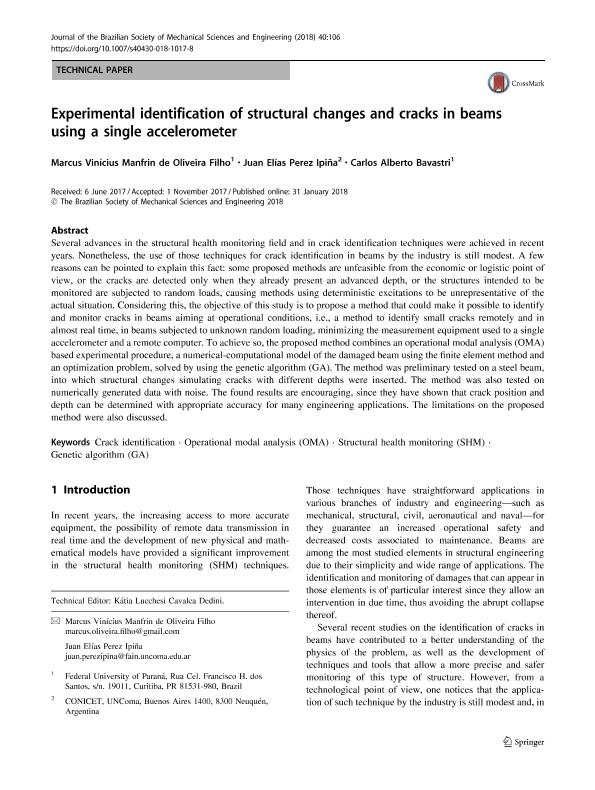Mostrar el registro sencillo del ítem
dc.contributor.author
de Oliveira Filho, Marcus Vinícius Manfrin
dc.contributor.author
Perez Ipiña, Juan Elias

dc.contributor.author
Bavastri, Carlos Alberto
dc.date.available
2020-08-07T15:25:37Z
dc.date.issued
2018-01
dc.identifier.citation
de Oliveira Filho, Marcus Vinícius Manfrin; Perez Ipiña, Juan Elias; Bavastri, Carlos Alberto; Experimental identification of structural changes and cracks in beams using a single accelerometer; Springer Heidelberg; Journal of the Brazilian Society of Mechanical Sciences and Engineering; 40; 2; 1-2018; 106-120
dc.identifier.issn
1678-5878
dc.identifier.uri
http://hdl.handle.net/11336/111159
dc.description.abstract
Several advances in the structural health monitoring field and in crack identification techniques were achieved in recent years. Nonetheless, the use of those techniques for crack identification in beams by the industry is still modest. A few reasons can be pointed to explain this fact: some proposed methods are unfeasible from the economic or logistic point of view, or the cracks are detected only when they already present an advanced depth, or the structures intended to be monitored are subjected to random loads, causing methods using deterministic excitations to be unrepresentative of the actual situation. Considering this, the objective of this study is to propose a method that could make it possible to identify and monitor cracks in beams aiming at operational conditions, i.e., a method to identify small cracks remotely and in almost real time, in beams subjected to unknown random loading, minimizing the measurement equipment used to a single accelerometer and a remote computer. To achieve so, the proposed method combines an operational modal analysis (OMA) based experimental procedure, a numerical-computational model of the damaged beam using the finite element method and an optimization problem, solved by using the genetic algorithm (GA). The method was preliminary tested on a steel beam, into which structural changes simulating cracks with different depths were inserted. The method was also tested on numerically generated data with noise. The found results are encouraging, since they have shown that crack position and depth can be determined with appropriate accuracy for many engineering applications. The limitations on the proposed method were also discussed.
dc.format
application/pdf
dc.language.iso
eng
dc.publisher
Springer Heidelberg

dc.rights
info:eu-repo/semantics/openAccess
dc.rights.uri
https://creativecommons.org/licenses/by-nc-sa/2.5/ar/
dc.subject
Crack identification
dc.subject
Operational modal analysis
dc.subject
Structural health monitoring
dc.subject
Genetic algorithm
dc.subject.classification
Otras Ingeniería Mecánica

dc.subject.classification
Ingeniería Mecánica

dc.subject.classification
INGENIERÍAS Y TECNOLOGÍAS

dc.title
Experimental identification of structural changes and cracks in beams using a single accelerometer
dc.type
info:eu-repo/semantics/article
dc.type
info:ar-repo/semantics/artículo
dc.type
info:eu-repo/semantics/publishedVersion
dc.date.updated
2020-03-11T13:05:57Z
dc.identifier.eissn
1806-3691
dc.journal.volume
40
dc.journal.number
2
dc.journal.pagination
106-120
dc.journal.pais
Alemania

dc.journal.ciudad
Berlin
dc.description.fil
Fil: de Oliveira Filho, Marcus Vinícius Manfrin. Universidade Federal do Paraná; Brasil
dc.description.fil
Fil: Perez Ipiña, Juan Elias. Consejo Nacional de Investigaciones Científicas y Técnicas; Argentina. Universidad Nacional del Comahue; Argentina
dc.description.fil
Fil: Bavastri, Carlos Alberto. Universidade Federal do Paraná; Brasil
dc.journal.title
Journal of the Brazilian Society of Mechanical Sciences and Engineering

dc.relation.alternativeid
info:eu-repo/semantics/altIdentifier/url/http://link.springer.com/10.1007/s40430-018-1017-8
dc.relation.alternativeid
info:eu-repo/semantics/altIdentifier/doi/http://dx.doi.org/10.1007/s40430-018-1017-8
Archivos asociados
